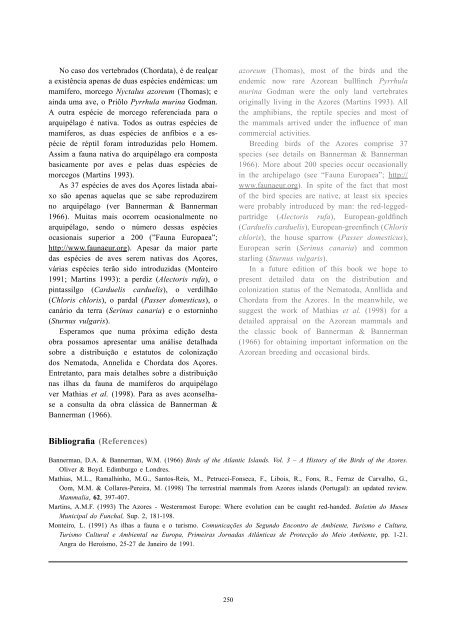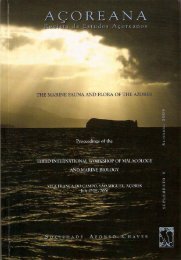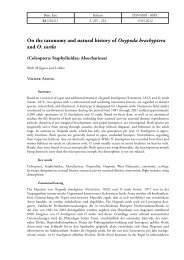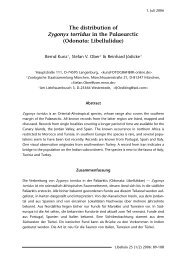(eds.) (2005). - Portal da Biodiversidade dos Açores - Universidade ...
(eds.) (2005). - Portal da Biodiversidade dos Açores - Universidade ...
(eds.) (2005). - Portal da Biodiversidade dos Açores - Universidade ...
Create successful ePaper yourself
Turn your PDF publications into a flip-book with our unique Google optimized e-Paper software.
No caso <strong>dos</strong> vertebra<strong>dos</strong> (Chor<strong>da</strong>ta), é de realçar<br />
a existência apenas de duas espécies endémicas: um<br />
mamífero, morcego Nyctalus azoreum (Thomas); e<br />
ain<strong>da</strong> uma ave, o Priôlo Pyrrhula murina Godman.<br />
A outra espécie de morcego referencia<strong>da</strong> para o<br />
arquipélago é nativa. To<strong>dos</strong> as outras espécies de<br />
mamíferos, as duas espécies de anfíbios e a espécie<br />
de réptil foram introduzi<strong>da</strong>s pelo Homem.<br />
Assim a fauna nativa do arquipélago era composta<br />
basicamente por aves e pelas duas espécies de<br />
morcegos (Martins 1993).<br />
As 37 espécies de aves <strong>dos</strong> <strong>Açores</strong> lista<strong>da</strong> abaixo<br />
são apenas aquelas que se sabe reproduzirem<br />
no arquipélago (ver Bannerman & Bannerman<br />
1966). Muitas mais ocorrem ocasionalmente no<br />
arquipélago, sendo o número dessas espécies<br />
ocasionais superior a 200 (”Fauna Europaea”;<br />
http://www.faunaeur.org). Apesar <strong>da</strong> maior parte<br />
<strong>da</strong>s espécies de aves serem nativas <strong>dos</strong> <strong>Açores</strong>,<br />
várias espécies terão sido introduzi<strong>da</strong>s (Monteiro<br />
1991; Martins 1993): a perdiz (Alectoris rufa), o<br />
pintassilgo (Carduelis carduelis), o verdilhão<br />
(Chloris chloris), o par<strong>da</strong>l (Passer domesticus), o<br />
canário <strong>da</strong> terra (Serinus canaria) e o estorninho<br />
(Sturnus vulgaris).<br />
Esperamos que numa próxima edição desta<br />
obra possamos apresentar uma análise detalha<strong>da</strong><br />
sobre a distribuição e estatutos de colonização<br />
<strong>dos</strong> Nemato<strong>da</strong>, Anneli<strong>da</strong> e Chor<strong>da</strong>ta <strong>dos</strong> <strong>Açores</strong>.<br />
Entretanto, para mais detalhes sobre a distribuição<br />
nas ilhas <strong>da</strong> fauna de mamíferos do arquipélago<br />
ver Mathias et al. (1998). Para as aves aconselhase<br />
a consulta <strong>da</strong> obra clássica de Bannerman &<br />
Bannerman (1966).<br />
Bibliografia (References)<br />
250<br />
azoreum (Thomas), most of the birds and the<br />
endemic now rare Azorean bullfinch Pyrrhula<br />
murina Godman were the only land vertebrates<br />
originally living in the Azores (Martins 1993). All<br />
the amphibians, the reptile species and most of<br />
the mammals arrived under the influence of man<br />
commercial activities.<br />
Breeding birds of the Azores comprise 37<br />
species (see details on Bannerman & Bannerman<br />
1966). More about 200 species occur occasionally<br />
in the archipelago (see “Fauna Europaea”; http://<br />
www.faunaeur.org). In spite of the fact that most<br />
of the bird species are native, at least six species<br />
were probably introduced by man: the red-leggedpartridge<br />
(Alectoris rufa), European-goldfinch<br />
(Carduelis carduelis), European-greenfinch (Chloris<br />
chloris), the house sparrow (Passer domesticus),<br />
European serin (Serinus canaria) and common<br />
starling (Sturnus vulgaris).<br />
In a future edition of this book we hope to<br />
present detailed <strong>da</strong>ta on the distribution and<br />
colonization status of the Nemato<strong>da</strong>, Annlli<strong>da</strong> and<br />
Chor<strong>da</strong>ta from the Azores. In the meanwhile, we<br />
suggest the work of Mathias et al. (1998) for a<br />
detailed appraisal on the Azorean mammals and<br />
the classic book of Bannerman & Bannerman<br />
(1966) for obtaining important information on the<br />
Azorean breeding and occasional birds.<br />
Bannerman, D.A. & Bannerman, W.M. (1966) Birds of the Atlantic Islands. Vol. 3 – A History of the Birds of the Azores.<br />
Oliver & Boyd. Edimburgo e Londres.<br />
Mathias, M.L., Ramalhinho, M.G., Santos-Reis, M., Petrucci-Fonseca, F., Libois, R., Fons, R., Ferraz de Carvalho, G.,<br />
Oom, M.M. & Collares-Pereira, M. (1998) The terrestrial mammals from Azores islands (Portugal): an up<strong>da</strong>ted review.<br />
Mammalia, 62, 397-407.<br />
Martins, A.M.F. (1993) The Azores - Westernmost Europe: Where evolution can be caught red-handed. Boletim do Museu<br />
Municipal do Funchal, Sup. 2, 181-198.<br />
Monteiro, L. (1991) As ilhas a fauna e o turismo. Comunicações do Segundo Encontro de Ambiente, Turismo e Cultura,<br />
Turismo Cultural e Ambiental na Europa, Primeiras Jorna<strong>da</strong>s Atlânticas de Protecção do Meio Ambiente, pp. 1-21.<br />
Angra do Heroísmo, 25-27 de Janeiro de 1991.

















